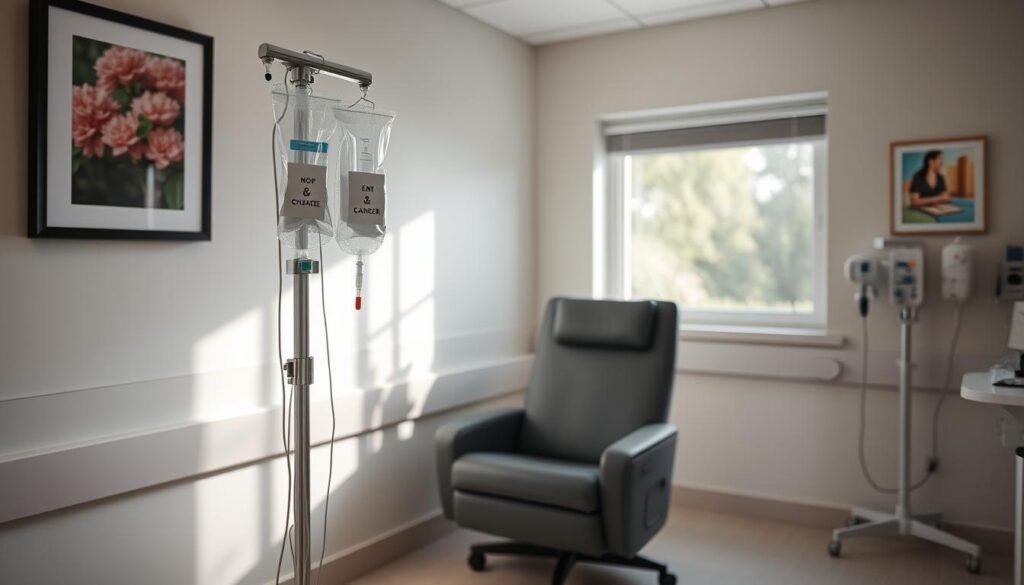Did you know about 30% of people find out they have non-small cell lung cancer (NSCLC) when it’s already at stage III? This is a key moment in the fight against lung cancer. It brings challenges but also chances to beat the disease. Nowadays, there are many ways to treat stage 3 lung cancer. These methods consider what each patient needs.
Treatment for stage III lung cancer depends on a few things. These include how healthy the person is, how well their lungs work, and specific details of the cancer. The aim is to use a combination of treatments. This could mean surgery, chemotherapy, and radiation therapy. The point is to get the best results for the patient. To learn more about the treatment options, visit Cancer.org.
The way we treat stage III lung cancer is always getting better. This is thanks to ongoing medical research. There’s hope in new treatments that focus on each patient’s specific situation. This field keeps growing, offering new ways to tackle this tough disease.
Key Takeaways
- About 30% of lung cancer cases are diagnosed at stage III, indicating a critical phase for treatment decisions.
- Multimodal treatments typically involve a blend of surgical resection, chemotherapy, and radiation therapy.
- Survival rates for stage III non-small cell lung cancer range significantly, with approximately 36% for stage IIIA and 13% for stage IIIC.
- Personalized treatment plans are becoming standard practice to ensure tailored therapies suited to each patient.
- Continued advancements in targeted therapies and clinical trials are paving the way for improved patient outcomes.
Understanding Stage 3 Lung Cancer
Understanding stage 3 lung cancer starts with knowing it mostly involves non-small cell lung cancer (NSCLC). NSCLC makes up 80-85% of lung cancer cases. Stage 3 is crucial because it’s about one-third of all lung cancer diagnoses. This stage shows big tumor growth and might include nearby lymph nodes. Stage 3 has different levels, called IIIA, IIIB, and IIIC, each with its own treatment challenges.
The survival rates for NSCLC differ depending on where the tumor is. The American Cancer Society says localized cases have a 5-year survival rate of 60%. If the cancer has spread regionally, the rate drops to 33%. For cases that have spread far, the survival rate is only 6%. Knowing these details helps pick the right treatment.
Creating a personalized treatment plan is key. Treatments may include chemotherapy, radiation, and surgery. Newer options like targeted therapy and immunotherapy are also helping patients. Thanks to these treatments, many people with stage 3 lung cancer can live longer periods without cancer growing back. This highlights the different outcomes lung cancer patients might have.
Types of Stage 3 Lung Cancer
Stage 3 lung cancer has three subcategories: stage IIIA, IIIB, and IIIC. Each category has its unique traits and treatments. It’s vital to know these types to plan treatment correctly.
Stage IIIA lung cancer features tumors over 5 centimeters. These tumors have reached nearby lymph nodes but haven’t spread far. Lymph node involvement shows the disease has advanced. This needs targeted treatment strategies.
Stage IIIB sees tumors spread to lymph nodes on the chest’s opposite side. This spread means treatment is more complex. It often requires multiple therapies. Tailored treatment plans are crucial here.
Stage IIIC lung cancer marks a major progression. Tumors are larger than 7 centimeters or affect vital structures like the heart. Treatment aims to manage symptoms and improve life quality at this stage.
Knowing the different types of lung cancer in stage 3 is essential. It helps oncologists pick the right treatment methods. For more on lung cancer stages and types, check cancer research websites.
Symptoms of Stage 3 Lung Cancer
Stage 3 lung cancer comes with many concerning symptoms that shouldn’t be ignored. These include a persistent cough and chest pain which tend to get worse. Over time, coughing up blood and intense pain can occur. Other signs are loss of appetite, unexpected weight loss, difficulty breathing, feeling very tired, and general weakness. Frequent infections like bronchitis and pneumonia are common, along with new wheezing sounds.
As lung cancer advances, new symptoms may emerge. Patients might feel bone pain, suffer from headaches, or have trouble moving their arms and legs. They could also feel dizzy, have problems keeping their balance, experience seizures, and even see their skin and eyes turn yellow from jaundice. Enlarged lymph nodes can indicate that the cancer is spreading. Sometimes, specific conditions, such as Horner syndrome or superior vena cava syndrome, might appear.
Spotting these symptoms of stage 3 lung cancer early on is crucial. Early detection helps doctors tailor treatment more effectively. This aims to better the lives of those facing this tough diagnosis.
| Common Symptoms | Symptoms When Cancer Spreads |
|---|---|
| Persistent cough | Bone pain |
| Bloody cough | Headache |
| Chest pain | Arm or leg weakness or numbness |
| Hoarseness | Dizziness or balance problems |
| Loss of appetite | Seizures |
| Unintentional weight loss | Yellowing of the skin and eyes |
| Shortness of breath | Swollen lymph nodes |
| Tiredness | Possibility of Horner syndrome or superior vena cava syndrome |
| Weakness | |
| Repeat bronchitis and pneumonia | |
| New wheezing |
Diagnosis and Staging Processes
Finding out someone has stage 3 lung cancer involves several steps. Doctors start with basic tests like chest X-rays. They then move on to more detailed ones, such as CT and PET scans.
These tests help doctors see how big the tumor is and if it has reached the lymph nodes. Knowing this is key to plan the best treatment.
After these tests, doctors may do a special procedure called endobronchial ultrasound-guided fine-needle aspiration (EBUS-TBNA). This method helps them learn more about the lymph nodes in the chest area. It’s a less invasive way to get important information about the cancer’s spread.
Finding the stage of lung cancer is done by a set system. It classifies non-small cell lung cancer from stage 0 to IV. Stage 3 has three parts: IIIA, IIIB, and IIIC, which depend on tumor size and where it has spread.
This detailed staging helps doctors create the best plan for each person.
A team of experts works together to consider everything that could affect the patient’s health. They create a care plan that’s focused on both beating the cancer and supporting the patient’s overall health. This approach aims to give the best chance for a good outcome.
Treatment Stage 3 Lung Cancer: Options and Latest Care
Treating stage 3 lung cancer involves learning about treatment options. It requires a strategy tailored to each patient. This plan might include chemotherapy, radiation, and surgery.
Multimodal Treatment Approaches
Early on, chemo and radiation work together to shrink tumors. This makes them easier to remove later. Clinical trials also offer new treatments that can improve patient outcomes.
Surgical Options
The type of surgery for lung cancer depends on the tumor and the patient’s health. Here are the options:
| Type of Surgery | Description |
|---|---|
| Lobectomy | Removes one lung lobe. Best for localized tumors. |
| Pneumonectomy | Takes out an entire lung. Needed for large tumors. |
| Radiofrequency Ablation (RFA) | A less invasive method. Targets tumors at lung’s edge. |
If tumors can’t be removed, chemoradiation is followed by immunotherapy. Adding targeted therapy for certain mutations is crucial.
Chemotherapy Regimens for Stage 3 Lung Cancer
Chemotherapy plans are key in treating stage 3 lung cancer. They use a mix of drugs to fight cancer cells, often helping patients do better. Doctors typically use drugs like cisplatin and carboplatin in these plans.
Platinum-Based Chemotherapy
For stage 3 lung cancer, platinum-based chemotherapy is a top choice. Medicines like cisplatin and carboplatin are used often. They can be used alone or with other drugs. These drugs damage cancer cell DNA, stopping their growth. Often, this treatment is done before surgery to shrink tumors, making them easier to remove.
Combination Therapy
Combination therapy uses different drugs together to fight lung cancer more effectively. It may also use immunomodulating agents with regular chemotherapy drugs. Studies show this approach can greatly increase survival rates for stage IIIA and IIIB lung cancer. By attacking cancer in multiple ways, this therapy can work better for patients.

Radiation Therapy Advancements
Recent advances have made a big difference in treating stage 3 lung cancer. Techniques like stereotactic body radiation therapy (SBRT) and intensity-modulated radiation therapy (IMRT) focus radiation precisely. This means less harm to healthy tissues and better tumor control.
External beam radiation therapy is still vital in treating lung cancer. It often goes hand in hand with chemotherapy. This mix boosts local control and survival rates. Combining radiation and chemotherapy has shown encouraging outcomes, underlining the value of using multiple treatments together.
A detailed look at studies proves the effectiveness of these advancements:
| Study | Year | Focus | Key Findings |
|---|---|---|---|
| TYROL Registry | 2015 | NSCLC Patient Outcomes | Longitudinal study of 2293 NSCLC patients. |
| TNM Staging Comparison | 2022 | Validation of Staging | Validated the 8th edition of TNM staging for NSCLC. |
| ESPATUE Trial | 2015 | Surgery vs. Chemoradiotherapy | Comparison of surgical outcomes versus chemoradiotherapy for resectable stage IIIA(N2). |
| PACIFIC Trial | 2022 | Durvalumab After Chemoradiotherapy | Reported five-year survival outcomes post-chemoradiotherapy. |
| AEGEAN Trial | 2023 | Neoadjuvant Durvalumab + Chemotherapy | Presented data on efficacy in resectable NSCLC. |
These important studies show how new radiation therapy methods have changed lung cancer treatment. Thanks to external beam radiation therapy, patients see better accuracy in treatment and improved chances of recovery. It’s a major advancement in fighting this disease.
Targeted Therapy and Immunotherapy for Lung Cancer
Targeted therapy and immunotherapy are leading the way in lung cancer advancements. These methods offer tailored treatments. They focus on genetic mutations and boost the immune response to cancer. Treatments like osimertinib and alectinib are used for EGFR and ALK mutations in non-small cell lung cancer (NSCLC).
About 5% of NSCLC patients have ALK gene changes. This makes ALK inhibitors like crizotinib, ceritinib, and alectinib good for metastatic cases. Immunotherapy treatments include pembrolizumab and nivolumab. They help the immune system find and kill cancer cells by affecting PD-1 and PD-L1 pathways.
Many targeted therapies tackle specific cancer drivers:
- Crizotinib and entrectinib are for ROS1 gene changes in metastatic NSCLC.
- TEPotinib treats the MET gene alteration.
- After immunotherapy or chemo, selpercatinib targets RET gene fusions.
- Sotorasib is used for the K-RAS mutation in advanced NSCLC.
- Larotrectinib or entrectinib treat NTRK gene fusions.
- Dabrafenib plus trametinib targets the BRAF V600 mutation in metastatic NSCLC.
- Nintedanib is a multi-kinase inhibitor for adenocarcinoma.
For specific stages, immunotherapy drugs like durvalumab and atezolizumab are key. They improve survival rates and quality of life for stage 3 lung cancer patients. These therapies are significant steps forward.

Clinical Trials and Their Importance
Clinical trials are key to advancing lung cancer research and finding new treatments. They test new ways to use drugs, radiation, and surgery. Patients in these trials get extra care from the study team to meet their needs.
Most new lung cancer treatments come from clinical trials. The National Comprehensive Cancer Network (NCCN) says they are good options for lung cancer patients. This gives them access to new therapies and lets them help future patients.
Clinical trials have different phases, each with its own goal. Patients might get a new drug, standard therapy, or both. If there’s a placebo, everyone knows ahead of time. Since 2020, over 15 new drugs for lung cancer have been approved thanks to trials.
Biomarker testing is crucial for matching lung cancer types with the right treatments. Trials test safety and how well treatments work together. This helps improve care for lung cancer patients.
- Patients with stage 4 lung cancer usually present with metastasis at diagnosis.
- Small cell lung cancer (SCLC) constitutes about 10 to 15% of lung cancer cases.
- Attending clinical trials empowers patients and caregivers by involving them in the future of lung cancer treatment.
If you’re looking for clinical trials, resources like myTomorrows can help find options. This proactive step fights lung cancer and brings hope for new discoveries.
Palliative Care Approaches
Palliative care is essential for those facing lung cancer. It aims to improve life quality, no matter the prognosis. It focuses on managing symptoms, easing pain, and caring for emotional needs. A team including doctors, nurses, and social workers provides this care, catering to every patient’s needs.
Lung cancer patients can talk about palliative care anytime during treatment. It’s helpful at all stages of cancer, not just at the end of life. Palliative care options include:
- Medications for pain relief
- Procedures to open airways
- Nutritional supplements
- Emotional support with counseling
- Help in making treatment choices
About 20% to 25% of non-small-cell lung cancer cases are stage III at diagnosis. Out of 237 studied patients, 55% did not get treatments aimed to cure. This choice often reflects factors like age, comorbidities, patient preferences, performance status, and weight loss.
Addressing palliative needs early is critical for patients with significant weight loss and poor lung function. These issues increase the risk of treatment toxicity and early death. So, beginning symptom management early is key.
Palliative care gives lung cancer patients all-around support. It improves their daily life and offers stability in tough times.

| Type of Palliative Care | Purpose |
|---|---|
| Pain Management | Relief from discomfort associated with lung cancer |
| Nutritional Support | Address nutritional deficiencies and weight loss recovery |
| Counseling Services | Provide emotional and psychological support |
| Airway Procedures | Improve lung function and breathing |
Conclusion
Early diagnosis and tailored treatment plans are key for stage 3 lung cancer. This includes surgery, chemotherapy, and radiation. Joining clinical trials can also offer access to new therapies.
It’s vital to work with top lung cancer specialists. They bring in-depth knowledge and ensure patients are cared for compassionately. With advances in research, the future looks brighter for those with stage 3 lung cancer.
Treatment now focuses more on the individual, improving the chances of better results. Teamwork between doctors, researchers, and patients is creating hope. This cooperation is essential for making progress against stage 3 lung cancer.
Looking for more information? Check out experts like Dr. Suresh Ramalingam and Dr. Alice Shaw. Their work in research and care is making a difference. Learn more at this resource.